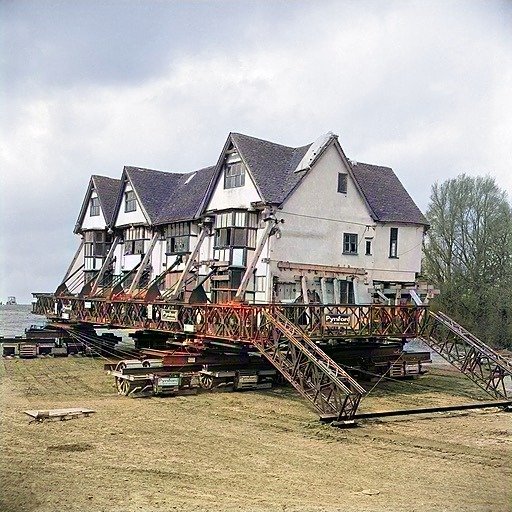Ballingdon Hall: 16th Century Gem Moved 200 Yards
In 1972, the 16th century Ballingdon Hall in Sudbury was remarkably moved 200 yards when the A131 road was improved.
Ballingdon Hall is a 16th-century Grade II-listed Elizabethan manor house, and at the time of the move, it was owned by John and Angela Hodge.
Its original position was south of the Stour at the base of Ballingdon Hill where the river curves round the Anglo-Saxon settlement of Sudbury.
However, in the winter of 1972, they decided to move the entire building half a mile up a hill in Sudbury, Suffolk, where they could enjoy commanding views over the Stour Valley and live happily ever after.
It was an outrageous fantasy and one that made headlines around the world, with many people thinking it was an impossible task.
What prompted moving the whole house was an encroaching modern housing estate on one side of the drive and expanding industrial warehouses on the other, near the busy A131 which was being improved.
They considered the possibility of dismantling the timber-framed building and reconstructing it elsewhere but were told it would probably not survive such a process.
Instead, they decided to move the house – intact – to the higher ground that John had recently purchased.
What followed was a remarkable feat of engineering, the entire complex was moved to a higher hill.
The four-bay windows had to be dismantled and each brick numbered for later reassembly up the hill.
The brick chimneys were also removed - then the house was encased in a steel frame and lifted it off its foundations.
By this time the structure which was lowered onto caterpillar tracks was essentially a timber building with a tiled roof.
This audacious move was intended to take a week, but in fact it took almost a year of very slow, very cautious manoeuvres to get the manor house up the hill.
Crowds of onlookers came to watch this remarkable feat and Angela charged them admission.
The money raised, around £3,000 in total, went towards the restoration of the 15th-century tower of the local All Saints Church.
Newspapers estimated that 50,000 turned up to watch over the year.
There were loudspeakers telling people not to get too close - if one of the wires had snapped it would have been catastrophic.
TV cameras also arrived to witness the event and Ballingdon made the ITV News, as well as the BBC’s popular children’s show Blue Peter.
It then took a further six years to fully reassemble and renovate the house in situ.
The cost of this relocation – which had made Sudbury famous around the world – was estimated to be about the price of building Ballingdon Hall again from scratch.
But John and Angela had rescued their home and were able to hide it away in 27 acres and 1,000 trees at the top of Ballingdon Hill.
The move also allowed for the back of the North Wing to be reimagined.
As the hall was put back together, chimney breasts were moved into the main body of the building, creating the fireplaces we see today.
Moving the house proved to be wise. One night, there was a fearful storm, which felled a giant oak next to the house’s old position.
Mrs Hodges doesn’t recall the exact figures, ‘It was expensive, let’s leave it at that.’
At one point, Pynford sued Mr Hodges, a solicitor, for £6,000 in unpaid bills, while he accused the firm of causing more than £75,000 worth of damage.
Mrs Hodge’s husband died four years ago and she found the 25-room, three-storey house too big - so, reluctantly, she put it on the market for £1.9 million and hoped to move somewhere more manageable.
‘I have been so happy here and have always realised that we are just custodians of the houses we live in. It’s time now to pass the house on.’
Today, Ballingdon Hall is a family home to Dr and Mrs Khan who have plans not only to preserve but also further restore this beautifully appointed sixteenth-century Elizabethan Manor House as its new custodians.
If you enjoyed this blog post, please follow Exploring GB on Facebook for daily travel content and inspiration.
Don’t forget to check out our latest blog posts below!
Thank you for visiting Exploring GB.
















